Does your business meet ADA specifications? If not, Southern Graphics Designs can design professional ADA compliant signage for your office quickly and efficiently. To assist you in understanding the signage requirements of the Americans with Disabilities Act, the facts and specifications are provided below:
The Americans with Disabilities Act was signed into law July 1990. It requires the removal of architectural and communication barriers from existing public accommodations, where readily achievable by January 26, 1992.
Alterations
Alterations to public accommodations and commercial facilities, which begin after January 26, 1992 must be made accessible to the maximum extent feasible.
New Construction
New construction of public accommodations and commercial facilities must be fully accessible. A facility is considered new construction if the last permit is certified after January 26, 1992 and the first certificate of occupancy is issued after January 26, 1992.
- - - - - - - - - - - - - - - - - - - - - - - - - - - - - - - - - - - - - - - - - - - - - - - - - - - - - - - - - - - - - - - - - - - - -
Privately Owned Facilities Affected by the Americans with Disabilities Act
Public Accommodations
Public accommodations are defined as private establishment s providing goods and services to the general public. Five million facilities are affected including hotels, hospitals, restaurants, schools, movie theaters, convention centers, and libraries, banks, museums, and airports.
Commercial Facilities
Commercial facilities are defined, as nonresidential establishments not open to the general public that affect commerce, such as factories, warehouses and office buildings. Commercial facilities are subject only to the requirements that new construction and alterations conform to the ADA accessibility guidelines.
Signage Guidelines and Specifications
Sign Finish & Contrast
The colors selected for the characters and symbols on a sign should be in marked contrast to the sign color. The characters and backgrounds of the signs must be eggshell, matte or some other non-glare surface.
Tactile & Braille Characters
Characters must be raised exactly 1/32". Grade 2 Braille must accompany characters. Typestyles Characters must be in upper case and sans serif or a simple serif style.
Typestyles
Characters must be in upper case and sans serif or a simple serif style. Characters must have a width-to-stroke ratio of between 3:5 and 1:1. Characters must have a stroke width-to-height ratio of between 1:5 and 1:10.
Character Height
Tactile characters must be a minimum 5/8" high, a maximum 2", all caps. Characters on overhead signs must be a minimum 3" high. Characters on Directional and Informational signs must be sized to viewing distance.
Symbols of Accessibility
 International Symbol of Accessibility
International Symbol of Accessibility
Facilities and elements required to be identified as accessible shall use the international symbol of accessibility.
 Text Telephones
Text Telephones
Text telephones required shall be identified by the international TDD symbol. In addition, if a facility has a public text telephone, directional signage indicating the location of the nearest text telephone shall be placed adjacent to all banks of telephones that do not contain a text telephone. Such directional signage shall include the international TDD symbol. If a facility has no banks of telephones, the directional signage shall be provided at the entrance (e.g., in a building directory).
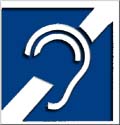 Assistive Listening Systems
Assistive Listening Systems
In assembly areas where permanently installed assistive listening systems are required, the availability of such systems shall be identified with signage that includes the international symbol of access for hearing impaired.
Volume Control Telephones
Telephones required to have volume control shall be identified by a sign containing a depiction of a telephone handset radiating sound waves.
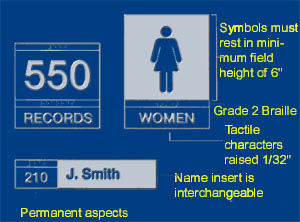 Permanent Signs
Permanent Signs
Signs which designate permanent rooms and spaces whose function will not change must comply with the highest standards, including tactile and Braille lettering. System 2/90's modular system allows for the application of ADA guidelines to the permanent aspect of these signs while providing interchangeability for the temporary aspects (see "210" sign below).
Temporary Signs
Building directories, menus and all other signs which provide temporary information about rooms and spaces, such as the current occupant's name, are not required to comply with ADA guidelines.
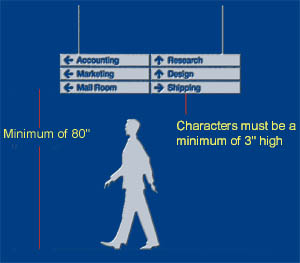 Overhead Signs
Overhead Signs
Signs which are projected or suspended overhead must meet requirements for clearance, character proportion and height, sign finish and contrast.
Directional and Information Signs
Wall mounted signs that provide direction to or information about functional spaces are not required to have tactile and Braille lettering. However, they must meet requirements for character proportion and height, sign finish and contrast.
Exterior Signage
If all of the entrances to the building are not accessible, then inaccessible entrances should be so labeled with directions to the nearest accessible entrance and the accessible entrances should be designated with the international symbol.
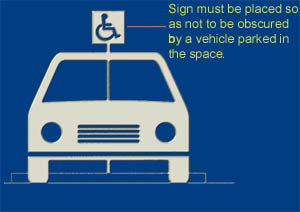 Parking Spaces
Parking Spaces
Accessible parking spaces shall be designated as reserved by a sign showing the symbol of accessibility. Such signs shall be located so that they cannot be obscured by a vehicle parked in the space.
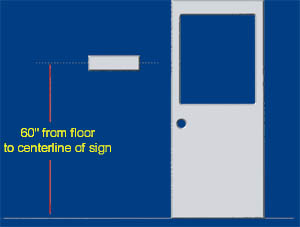 Mounting Location
Mounting Location
The sign shall be installed on the wall adjacent to the latch side of the door. Where there is no wall space to the latch side of the door, including at double leaf doors, signs shall be placed on the nearest adjacent wall. Mounting location shall be so that a person may approach within 3" of signage without encountering protruding objects or standing within the swing of a door.